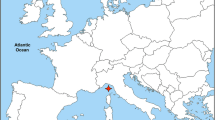Summary
Ampullary organs are found on the head and body of the African knife fishXenomystus nigri. Each organ consists of a duct connecting the basally located sensory cells with the surrounding water. The sensory epithelium is found in a chamber situated in the basal part of the epidermis, which most often is somewhat depressed into the dermis. Each organ contains four to eight sensory cells separated from each other by supporting cells. Both sensory and supporting cells are surrounded by mantle cells.
Apically, the pear-shaped sensory cells have a tuft of 40 to 60 microvilli and between these a short cilium; basally they are innervated by one large afferent nerve ending. No efferent endings have been observed.
Similar content being viewed by others
References
Braford, M. R., Jr (1982) African, but not Asian, notopterid fishes are electroreceptive: evidence from brain character.Neuroscience Letters 32, 35–9.
Bullock, T. H. (1981) Comparisons of the electric and acoustic senses and their central processing. InHearing and Sound Communication in Fishes (edited byTavolga, W. N., Popper, A. N. &Fay, R. R.), pp. 525–70. New York, Heidelberg, Berlin: Springer-Verlag.
Bullock, T. H. (1982) Electroreception.Annual Review of Neuroscience 5, 121–70.
Bullock, T. H., Bodznick, D. A. &Northcutt, R. G. (1983) The phylogenetic distribution of electroreception: evidence for convergent evolution of a primitive vertebrate sense modality.Brain Research Reviews 6, 25–46.
Bullock, T. H. &Heiligenberg, W. (eds) (1986)Electroreception. New York: John Wiley & Sons.
Bullock, T. H. &Northcutt, R. G. (1982) A new electroreceptive teleost:Xenomystus nigri (Osteoglossiformes: Notopteridae).Journal of Comparative Physiology 148, 345–52.
Bullock, T. H., Northcutt, R. G. &Bodznick, D. A. (1982) Evolution of electroreception.Trends in Neurosciences 5, 50–3.
Flock, Å. (1965) Electron microscopic and electrophysiological studies on the lateral line canal organ.Acta oto-laryngologica, Suppl.199, 1–90.
Fritzsch, B. &Wahnschaffe, U. (1983) The electroreceptive ampullary organs of urodeles.Cell and Tissue Research 229, 483–503.
Hama, K. (1978) A study of the fine structure of the pit organ of the common Japanese sea eelConger myriaster.Cell and Tissue Research 189, 375–88.
Istenić, L. &Bulog, B. (1984) Some evidence for the ampullary organs in the European cave salamanderProteus anguinus (Urodela, Amphibia).Cell and Tissue Research 235, 393–402.
Jørgensen, J. M. (1982) Fine structure of the ampullary organs of the bichirPolypterus senegalus Cuvier, 1829 (Pisces: Brachiopterygii) with some notes on the phylogenetic development of electroreceptors.Acta zoologica (Stockholm)63, 211–17.
Jørgensen, J. M. (1984) On the morphology of the electroreceptors of the two lungfish:Neoceratodus forsteri Krefft andProtopterus annectens Owen.Videnskabelige Meddelelser fra dansk naturhistorisk Forening 145, 77–85.
Jørgensen, J. M. (1985) On the fine structure of lateral-line canal organs of the herring (Clupea harengus).Journal of the Marine Biological Association of the United Kingdom 65, 751–8.
Kalmijn, A. M. (1974) The detection of electric fields from inanimate and animate sources other than electric organs. InHandbook of Sensory Physiology, Vol. III/3 (edited byFessard, A.), pp. 147–200. New York, Heidelberg, Berlin: Springer-Verlag.
Lissmann, H. W. (1958) On the function and evolution of electric organs in fish.Journal of Experimental Biology 35, 156–91.
Mullinger, A. M. (1964) The fine structure of ampullary electric receptors inAmiurus.Proceedings of the Royal Society of London, Series B 160, 345–59.
Murray, R. W. (1974) The ampullae of Lorenzini. InHandbook of Sensory Physiology, Vol. III/3 (edited byFessard, A.), pp. 125–46. New York, Heidelberg, Berlin: Springer-Verlag.
Ronan, M. C. &Bodznick, D. (1986) End buds: non-ampullary electroreceptors in adult lampreys.Journal of Comparative Physiology 158, 9–15.
Roth, A. &Tscharntke, H. (1976) Ultrastructure of the ampullary electroreceptors in lungfish and Brachiopterygii.Cell and Tissue Research 173, 95–108.
Scheich, H. &Bullock, T. H. (1974) The detection of electric fields from electric organs. InHandbook of Sensory Physiology, Vol. III/3 (edited byFessard, A.), pp. 201–56. New York, Heidelberg, Berlin: Springer-Verlag.
Szabo, T. (1974) Anatomy of the specialized lateral line organs of electroreception. InHandbook of Sensory Physiology, Vol. III/3 (edited byFessard, A.), pp. 13–58. New York, Heidelberg, Berlin: Springer-Verlag.
Szabo, T. &Fessard, A. (1974) Physiology of electroreceptors. InHandbook of Sensory Physiology, Vol. III/3 (edited byFessard, A.), pp. 59–124. New York, Heidelberg, Berlin: Springer-Verlag.
Viancour, T. A. (1979) Peripheral electrosense physiology: a review of recent findings.Journal de Physiologie, Paris 75, 321–33.
Wahnschaffe, U., Fritzsch, B. &Himstedt, W. (1985) The fine structure of the lateral-line organs of larvalIchthyophis (Amphibia: Gymnophiona).Journal of Morphology 186, 369–77.
Whitear, M. &Lane, B. (1981) Bar synapses in the end buds of lamprey skin.Cell and Tissue Research 216, 445–8.
Zakon, H. (1986) The electroreceptive periphery. InElectroreception (edited byBullock, T. H. &Heiligenberg, W.), pp. 103–56. New York: John Wiley & Sons.
Author information
Authors and Affiliations
Rights and permissions
About this article
Cite this article
Jørgensen, J.M., Bullock, T.H. Organization of the ampullary organs of the African knife fishXenomystus nigri (Teleostei: Notopteridae). J Neurocytol 16, 311–315 (1987). https://doi.org/10.1007/BF01611343
Received:
Revised:
Accepted:
Issue Date:
DOI: https://doi.org/10.1007/BF01611343




